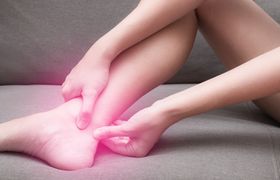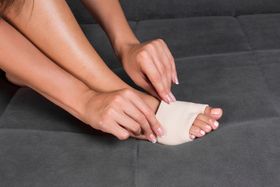Metatarsalgia: Causes for Swelling and 10 Ways to Reduce It
Published January 29, 2022.

Metatarsalgia is a condition in which pain occurs in the sole or ball of the foot. Usually, this pain is aching by nature, worsened by activity, and occurs with other symptoms like swelling and bruising at the metatarsals. Metatarsalgia can lead to joint stiffness, limited range of motion (ROM), and pain in the lower back and hip due to altered body mechanics.
Causes of Metatarsalgia
Generally, metatarsalgia is due to repetitive loading of the foot and is caused by:
- Intense training During running, jumping, and climbing activities, the front of the foot absorbs more force than usual. Without proper shoes to absorb some of this force, pain can result at the head of the metatarsals.
- High arch A high foot arch places extra pressure on the foot around the metatarsals. This is especially true around the second metatarsal head. This redistribution of weight can lead to metatarsalgia.
- Poorly fitting shoes High-heeled shoes and shoes with a narrow toe box can contribute to the development of metatarsalgia.
- Foot deformities Hammertoes, claw toes, bunions, or any bumps in the foot due to foot deformities can lead to metatarsalgia.
- Stress fracture Repetitive loading can cause small breaks in the metatarsals due to advancing age. These fractures can make the toe bone more painful.
- Obesity The more you weigh, the more pressure on the ball of the foot.
11 Methods for Treating Metatarsalgia Swelling
Thankfully, the symptoms of metatarsalgia, including swelling, can be managed using any of the following methods;
6 Home Management Techniques
- Rest Between periods of intense activity like running or standing for long, keep the feet rested.
- Elevation When you’re not standing, ensure the foot is kept elevated above the heart.
- Ice You can apply ice to the ball of your foot for up to 20 minutes. By stimulating vasoconstriction, ice can help reduce inflammation and blood flow, resulting in less swelling.
- Weight reduction You can reduce pressure on the ball of your feet by performing a weight loss program.
- Non-steroidal anti-inflammatory medications (NSAIDs) NSAIDs help address the pain and swelling that results from metatarsalgia and also give room for other treatment methods.
- Activity modification There may be a need to change the activities you engage in daily. Where this is impossible, you may consider reducing the intensity and duration of the activities.
5 Other Non-conservative Management Techniques
- Physical therapy Working with a physical therapist may reduce swelling due to metatarsalgia. The physiotherapist will encourage normal foot biomechanics through gait retraining. Consequently, this will relieve the pressure on the ball of the foot and the resultant symptoms.
- Proper footwear Invest in high-quality footwear that has spacious toe room, is well cushioned, and provides adequate support for the arch, heel, and ball of the foot. Shoes with a stiff sole and a rocker bottom contour can reduce the pressure on the forefoot.
- Splinting You can ease the pressure temporarily on a joint by splinting the affected joint, which means strapping a piece of rigid material to the area to prevent movement.
- Custom orthotics: Orthotic inserts provide extra cushion and padding for the feet while absorbing pressure. This reduces the impact on the muscles, ligaments, and bones. Orthotics can be arch supports, metatarsal pads, or hammertoe crest pads. i. Metatarsal pads: If your shoes are already good, metatarsal pads can provide additional comfort. They cushion the metatarsal bones and will help bear the redirect some of the pressure off the affected metatarsal. ii. Taping/hammertoe crest pads: You can use taping to bring the toe back into its normal position. Similarly, you can use a hammertoe crest pad when there is a claw toe deformity that needs pushing back into position. iii. Arch supports: These reduce stress on the metatarsal heads and encourage roper biomechanics when walking.
- Corticosteroid injections Corticosteroids can temporarily improve the quality of life when injected into the affected joint. The relief can continue for up to 3 months in some cases.
Surgical Approach
When non-conservative treatment fails, surgery becomes an option. Since the goal of surgery is to remove the primary cause, the surgical approach will depend on the cause of the condition, its severity, and any complications it may have caused.
Factors That Increase the Risk of Metatarsalgia
Anyone can develop metatarsalgia, and the following factors can increase your chances:
- High-impact activities
- Obesity
- Foot conditions
- Inflammatory arthritis (rheumatoid arthritis or gout)
- Wearing high-heeled shoes
Can Metatarsalgia Be Cured?
Metatarsalgia can be easily managed. With management, one can expect a full recovery, especially when intervention is prompt and early. One factor that cannot be overstressed is the need for correctly fitted shoes. Whether for sports or daily activities, ensure you wear proper shoes with shock-absorbing insoles or arch supports, as these can prevent or minimize future episodes of metatarsalgia.








